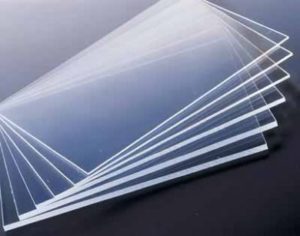Rising security threats have prompted our establishments to adopt secure armor for protection from unscrupulous elements. These establishments use armors usually made of polycarbonates and other forms of plastics. But security isn’t the only arena where bulletproof glass is used.
Industries and vehicles having heat- and pressure-intensive tasks, too, require their critical components to be made of ballistic glass, and these include aerospace, defense, automobile, plastics, and many other industries.
But just how strong and impenetrable are these materials?

What Is Bulletproof / Ballistic Glass?
Bulletproof Glass is often used as a misnomer for Polycarbonate- or Aramid-based composites. These materials are made of multiple layers of Polycarbonate and/or Aramid (Kevlar, Twaron, Nomex, and Technora) fibers.
A bulletproof glass is a multilayered composite that slows down high-impact projectiles and resists large amounts of heat and pressure. Each layer can be made of a different kind of plastic.
In this case, the glass is made of Polycarbonate formed from a reaction between bisphenol A and phosgene, and stacked with other plastics to give enhanced impact-resistance.
The layered structure of Polycarbonates, held by van der Waals forces and carbon-carbon double bonds, gives high Young’s Moduli which helps in reducing the impact from projectiles and also resisting high temperatures.
Whereas in the case of Aramid-based composites, the glass is made of ultra-thin fabrics synthesized from chloride- and amine- based compounds. The product is solidified and spun into high-tensile fibers.
The structure of Kevlar is far more intricate than Polycarbonates. Kevlar owes its high strength to the many inter-chain bonds. These intermolecular hydrogen bonds form between the carbonyl groups and NH centers. Additional strength is derived from aromatic stacking interactions between adjacent strands. These intertwined bonds provide Kevlar with high strength-to-weight ratios, high-tensile strengths, and higher impact resistance than Polycarbonates. Other bullet-proof materials include PVB, Acrylic Glass, Ionoplast polymers, and Ethylene Vinyl Acetate.
Working Principle
A bulletproof glass (or hard plastic composite), like regular glass, shatters upon impact, too. But unlike the latter, its multiple chemical bonds and layers absorb large amounts of energy from pressure (impact) and heat.
When an object strikes the surface, energy spreads out sideways through the layers. Because impact energy is divided between several layers of glass and plastic and spread over a large area, it is quickly absorbed, and the object is slowed down. The object no longer has enough energy to pierce through the layers.
But How Can you Get Bulletproof?
There are several factors that decide the safety of your composite material.
- Heat
High temperatures can soften the composite material and weaken bonds. Some composites like Kevlar are extremely hard at low temperatures. But as the thermal gradient rises, their bonds start losing integrity.
Also, prolonged exposure to even slightly above average temperatures can lead to softening of bonds. Most bulletproof windows and armor require a yearly maintenance. Defense and space applications, however, are equipped with composites that can take more than 1,500 degree Celsius.
To make the ideal bulletproof vest or heat shield, your material needs higher stacking density and several more chemical bonds.
- Bullet Caliber
Every bullet or heat armor is designed to take only specific amounts of impact or temperature. Impact resistance depends also on impulse (the number of times the object is impacted). Most bulletproof glasses are designed to take from 0.3mm to 0.50 magnum bullets. Designing vests to take beyond that is complicated, and technologies for the same are still under development.
The toughest known bulletproof armor is Aluminium Oxynitride. However, nanotechnology might be the key to the future of armors and shields.
- Company
The manufacturer is also the key for deciding how safe you or your products are from impact and heat. Selecting a producer that makes composites for defense and security industries is your best bet. If you, however, choose to go for a manufacturer that makes industrial Polycarbonates or aramids, they might not have the expertise to produce high-grade composites. At the most, you can protect yourself from bayonets.
Bottom Line
If your life and line of work require you to put yourself on the line of fire (metaphorically and literally), you need to pick your product with the utmost care and research.





